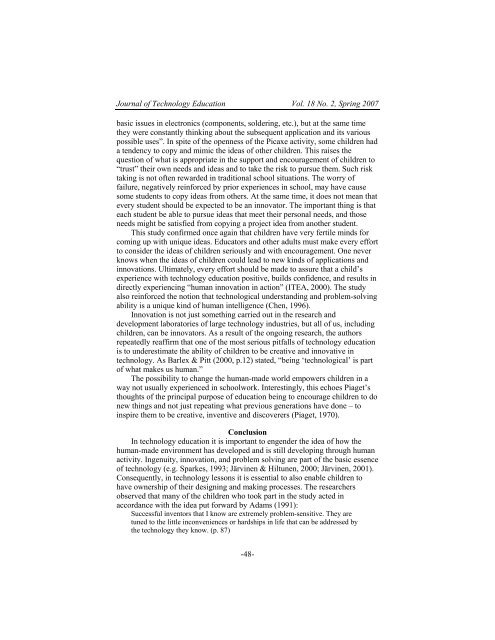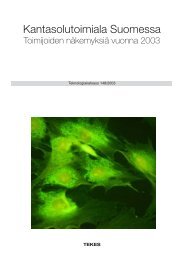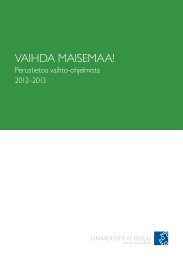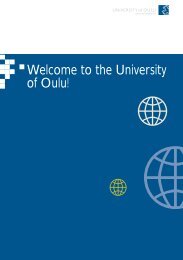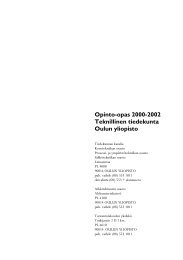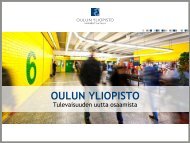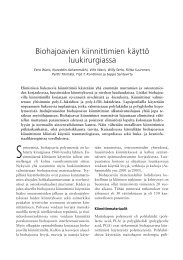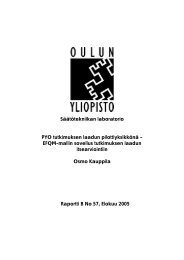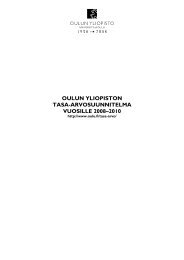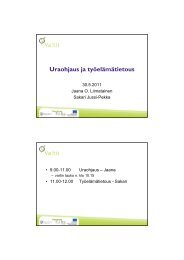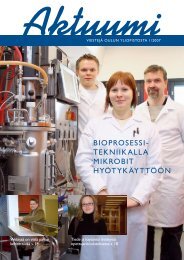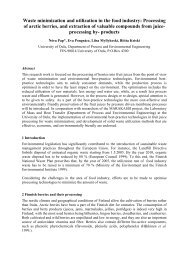A Study of Microcontrollers in Finnish Comprehensive Schools - Oulu
A Study of Microcontrollers in Finnish Comprehensive Schools - Oulu
A Study of Microcontrollers in Finnish Comprehensive Schools - Oulu
You also want an ePaper? Increase the reach of your titles
YUMPU automatically turns print PDFs into web optimized ePapers that Google loves.
Journal <strong>of</strong> Technology Education Vol. 18 No. 2, Spr<strong>in</strong>g 2007<br />
basic issues <strong>in</strong> electronics (components, solder<strong>in</strong>g, etc.), but at the same time<br />
they were constantly th<strong>in</strong>k<strong>in</strong>g about the subsequent application and its various<br />
possible uses”. In spite <strong>of</strong> the openness <strong>of</strong> the Picaxe activity, some children had<br />
a tendency to copy and mimic the ideas <strong>of</strong> other children. This raises the<br />
question <strong>of</strong> what is appropriate <strong>in</strong> the support and encouragement <strong>of</strong> children to<br />
“trust” their own needs and ideas and to take the risk to pursue them. Such risk<br />
tak<strong>in</strong>g is not <strong>of</strong>ten rewarded <strong>in</strong> traditional school situations. The worry <strong>of</strong><br />
failure, negatively re<strong>in</strong>forced by prior experiences <strong>in</strong> school, may have cause<br />
some students to copy ideas from others. At the same time, it does not mean that<br />
every student should be expected to be an <strong>in</strong>novator. The important th<strong>in</strong>g is that<br />
each student be able to pursue ideas that meet their personal needs, and those<br />
needs might be satisfied from copy<strong>in</strong>g a project idea from another student.<br />
This study confirmed once aga<strong>in</strong> that children have very fertile m<strong>in</strong>ds for<br />
com<strong>in</strong>g up with unique ideas. Educators and other adults must make every effort<br />
to consider the ideas <strong>of</strong> children seriously and with encouragement. One never<br />
knows when the ideas <strong>of</strong> children could lead to new k<strong>in</strong>ds <strong>of</strong> applications and<br />
<strong>in</strong>novations. Ultimately, every effort should be made to assure that a child’s<br />
experience with technology education positive, builds confidence, and results <strong>in</strong><br />
directly experienc<strong>in</strong>g “human <strong>in</strong>novation <strong>in</strong> action” (ITEA, 2000). The study<br />
also re<strong>in</strong>forced the notion that technological understand<strong>in</strong>g and problem-solv<strong>in</strong>g<br />
ability is a unique k<strong>in</strong>d <strong>of</strong> human <strong>in</strong>telligence (Chen, 1996).<br />
Innovation is not just someth<strong>in</strong>g carried out <strong>in</strong> the research and<br />
development laboratories <strong>of</strong> large technology <strong>in</strong>dustries, but all <strong>of</strong> us, <strong>in</strong>clud<strong>in</strong>g<br />
children, can be <strong>in</strong>novators. As a result <strong>of</strong> the ongo<strong>in</strong>g research, the authors<br />
repeatedly reaffirm that one <strong>of</strong> the most serious pitfalls <strong>of</strong> technology education<br />
is to underestimate the ability <strong>of</strong> children to be creative and <strong>in</strong>novative <strong>in</strong><br />
technology. As Barlex & Pitt (2000, p.12) stated, “be<strong>in</strong>g ‘technological’ is part<br />
<strong>of</strong> what makes us human.”<br />
The possibility to change the human-made world empowers children <strong>in</strong> a<br />
way not usually experienced <strong>in</strong> schoolwork. Interest<strong>in</strong>gly, this echoes Piaget’s<br />
thoughts <strong>of</strong> the pr<strong>in</strong>cipal purpose <strong>of</strong> education be<strong>in</strong>g to encourage children to do<br />
new th<strong>in</strong>gs and not just repeat<strong>in</strong>g what previous generations have done – to<br />
<strong>in</strong>spire them to be creative, <strong>in</strong>ventive and discoverers (Piaget, 1970).<br />
Conclusion<br />
In technology education it is important to engender the idea <strong>of</strong> how the<br />
human-made environment has developed and is still develop<strong>in</strong>g through human<br />
activity. Ingenuity, <strong>in</strong>novation, and problem solv<strong>in</strong>g are part <strong>of</strong> the basic essence<br />
<strong>of</strong> technology (e.g. Sparkes, 1993; Järv<strong>in</strong>en & Hiltunen, 2000; Järv<strong>in</strong>en, 2001).<br />
Consequently, <strong>in</strong> technology lessons it is essential to also enable children to<br />
have ownership <strong>of</strong> their design<strong>in</strong>g and mak<strong>in</strong>g processes. The researchers<br />
observed that many <strong>of</strong> the children who took part <strong>in</strong> the study acted <strong>in</strong><br />
accordance with the idea put forward by Adams (1991):<br />
Successful <strong>in</strong>ventors that I know are extremely problem-sensitive. They are<br />
tuned to the little <strong>in</strong>conveniences or hardships <strong>in</strong> life that can be addressed by<br />
the technology they know. (p. 87)<br />
-48-


